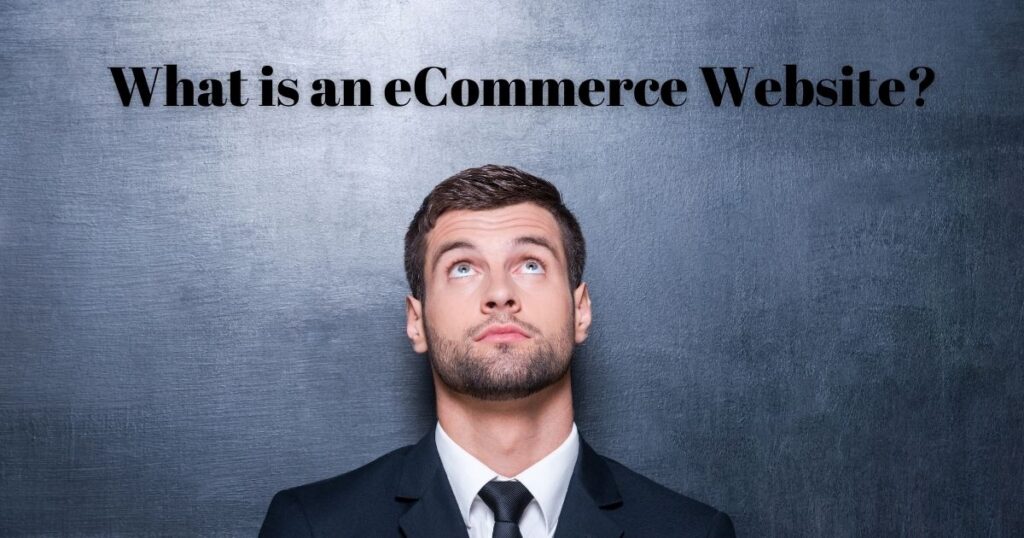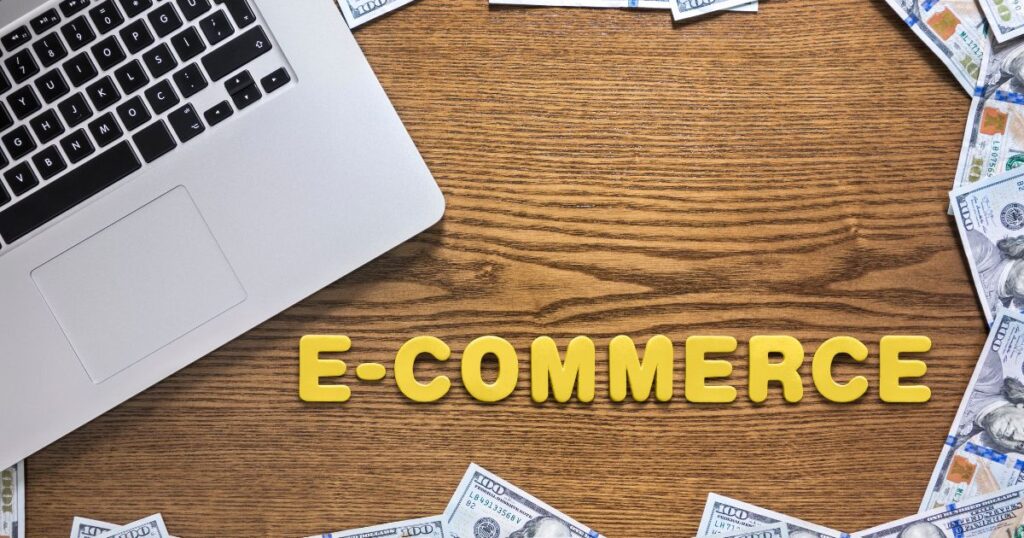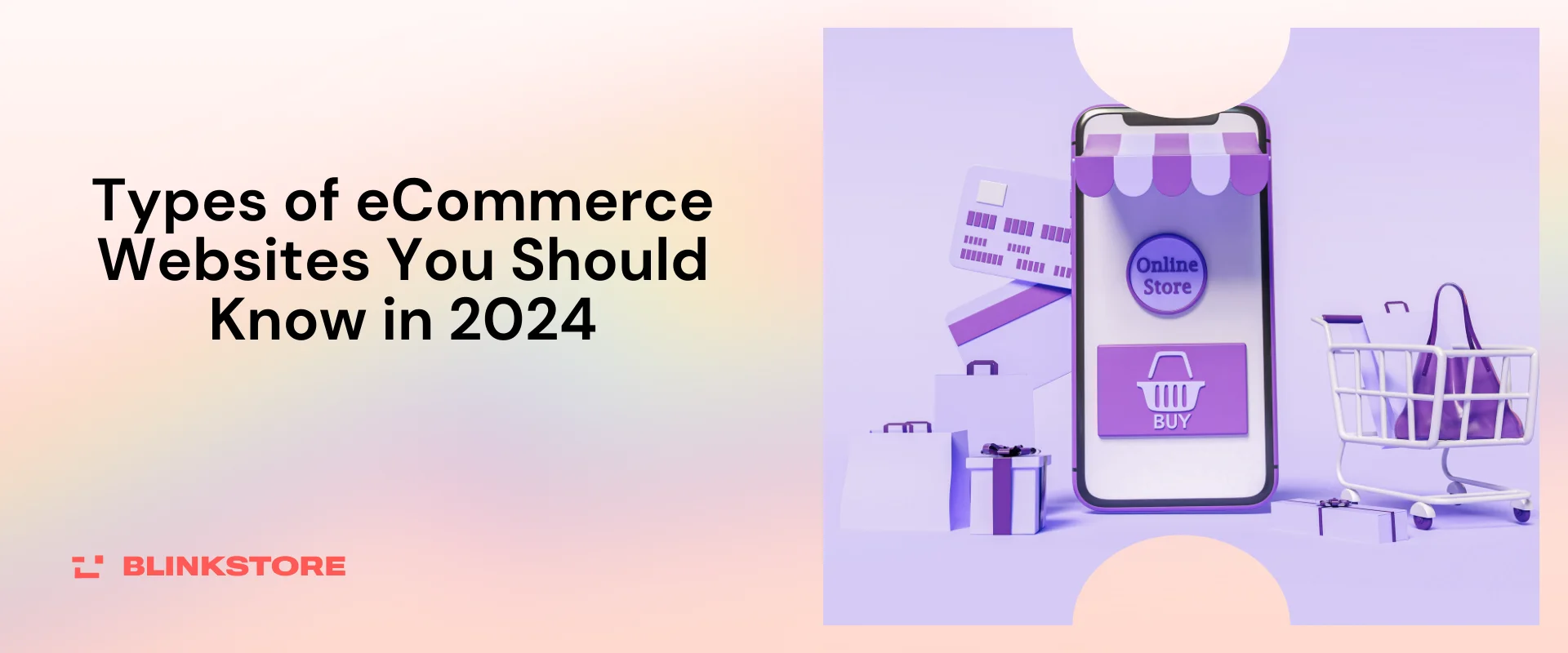The global eCommerce market is on track to hit over $7 trillion by 2025, highlighting just how crucial eCommerce websites have become in our daily lives. The convenience and accessibility it brings are transforming the way we shop. With just a click, folks can snag whatever they want from anywhere in the world. It’s changing the game, making shopping a breeze with a simple click.
Table of Contents
In this blog, we will explore the types of eCommerce website and chart a course for your digital success. Imagine where your online store isn’t just a transactional platform but a thriving hub tailored to your unique needs. Check our blog on “How To Start an Ecommerce Business In India – 2024 Best Guide” to start your eCommerce journey.
What is an eCommerce Website?

At its core, an eCommerce website is your digital storefront, the bustling market square in the virtual world. It’s more than a collection of products; it’s your brand, your identity pulsating with potential customers.
These types of eCommerce websites bridge the gap between your offerings and the ever-evolving demands of the digital consumer. As technology advances, so does the role of an eCommerce site – it’s not just a transaction, it’s an experience.
Types of eCommerce Business Models You Need to Know
There are various types of e-commerce models available, such as business-to-business (B2B), business-to-consumer (B2C), and consumer-to-consumer (C2C) among others. The choice of a particular model depends on your target audience and market niche.
a. B2C (Business to Consumer)
Witness the heartbeat of online shopping as B2C platforms connect businesses directly with individual consumers. Picture fashion empires and gadget havens, where a simple click brings your favorite products to your fingertips. For instance, imagine strolling through an e-clothing store, effortlessly adding chic ensembles to your cart.
b. B2B (Business to Business)
The B2B e-commerce envisions transactions revolving around bulk orders rather than individual purchases. These platforms serve as dynamic meeting grounds for businesses, streamlining wholesale transactions and fostering invaluable industry collaborations. Picture a platform where manufacturers efficiently connect with retailers to supply goods in quantities that keep industries buzzing.
Read more: B2B Dropshipping: How to Dominate Your Competition in 2024
c. C2C (Consumer to Consumer)
Step into the lively world of C2C eCommerce, where consumers become both buyers and sellers. Picture bustling online marketplaces reminiscent of a digital bazaar. Visualize individuals trading goods and services directly, creating a dynamic community where unique items find new homes.
d. C2B (Consumer to Business)
In this fascinating twist, consumers dictate the market’s pace. Imagine influencers, freelancers, and creative minds leveraging C2B sites to showcase their skills, products, and groundbreaking ideas. Envision a platform where your artistic endeavors captivate businesses seeking fresh perspectives, turning the traditional business model on its creative head.
e. D2C (Direct to Consumer)
For brands aiming to cut out the middleman, D2C platforms emerge as the solution. Envision companies empowered to sell directly to consumers, fostering a personalized and intimate brand-consumer relationship. Imagine a direct avenue where you, as a consumer, interact directly with your favorite brand, creating a more personalized shopping experience.
7 Different Types of eCommerce Websites With Examples

Get a quick understanding of different types of eCommerce Websites and choose which mode suits you well.
1. Single-Brand Websites
- Focus: Exclusively showcasing and selling products from a singular brand or company.
- Examples: Think industry giants like Nike, Apple, and beauty powerhouse Sephora.
- Benefits: Commanding brand control, fostering direct customer relationships, and weaving compelling brand narratives for effective storytelling.
- Challenges: Success hinges on robust brand recognition, potentially limiting product variety.
Pro Tip: Invest in immersive storytelling through engaging visuals and narratives to strengthen brand identity.
2. Online Marketplaces
- Focus: Serving as a bustling hub for transactions between diverse sellers and eager buyers.
- Examples: Powerhouses like Blinkstore, Amazon, Etsy, and eBay, offer a vast marketplace for varied products.
- Benefits: Diverse product offerings, a sprawling customer base, and simplified inventory management for sellers.
- Challenges: Navigating intense competition, managing lower profit margins, and relinquishing some control over branding.
Actionable Insight: Leverage advanced marketplace analytics tools to understand trends, optimize listings, and stay ahead of the competition.
3. Subscription-Based Websites
- Focus: Providing products or services through recurring subscriptions, creating a reliable revenue stream.
- Examples: Trailblazers like Dollar Shave Club, culinary maestro Blue Apron, and entertainment giant Netflix.
- Benefits: Ensuring predictable revenue, fostering strong customer loyalty, and unlocking upsell opportunities.
- Challenges: Balancing customer acquisition costs, effectively managing churn, and continuously delivering compelling value.
Statistical Insight: According to industry reports, businesses with subscription models witness a 5-10% increase in annual revenue.
4. Content-Driven Websites
- Focus: Cultivating an audience through valuable content, seamlessly transitioning into product or service sales.
- Examples: Industry influencers such as TechCrunch, culinary inspiration from The Kitchn, and financial wisdom from NerdWallet.
- Benefits: Enjoying organic website traffic, fostering robust brand trust, and reaching a targeted audience poised for sales.
- Challenges: Balancing content creation costs, patiently building an audience, and addressing potential delays in conversion.
Pro Tip: Utilize SEO tools to identify high-performing content topics, enhancing organic visibility.
5. Social Commerce Websites
- Focus: Directly selling products and engaging customers through popular social media platforms.
- Examples: Capitalize on Instagram shopping, tap into Facebook Marketplace, and embrace the trend with TikTok live stream shopping.
- Benefits: Tapping into vast social media audiences, fostering visual engagement, and facilitating real-time customer interaction.
- Challenges: Navigating algorithm dependencies, adhering to platform policies, and effectively managing multiple platforms.
Actionable Insight: Leverage influencer collaborations for increased visibility and credibility.
6. Flash Deal Websites
- Focus: Providing time-sensitive, discounted products in a dynamic buying environment.
- Examples: Industry leaders Groupon, Gilt, and Woot offering excitement, impulse buys, and swift inventory turnover.
- Benefits: Generating excitement, encouraging impulse purchases, and swiftly clearing inventory.
- Challenges: Managing low-profit margins, addressing customer churn linked to limited-time offers, and ensuring product quality.
Pro Tip: Use scarcity tactics and countdown timers to heighten the sense of urgency during flash sales.
7. Niche Websites
- Focus: Tailoring offerings to a specific niche market with specialized products or services.
- Examples: Dive into niches like vegan fitness apparel, eco-friendly home goods, or vintage car parts.
- Benefits: Navigating reduced competition, fostering a loyal customer base, and establishing a potent brand identity within the niche.
- Challenges: Adapting to limited market size, potentially facing lower sales volume, and staying attuned to evolving niche trends.
Actionable Insight: Leverage niche-specific forums and communities to understand customer pain points and preferences.
Benefits of eCommerce Websites

eCommerce websites have many benefits for both consumers and sellers they are:
1. Global Reach: Break down geographical barriers by reaching a global audience with your online store.
2. Convenience: Shop anytime, anywhere – browse products, compare prices, and make purchases from the comfort of your home.
3. 24/7 Availability: Access your e-commerce website round-the-clock, catering to your needs regardless of location or time zone.
4. Cost Savings: Reduce traditional retail costs like storefront rent, utilities, and staffing, leading to potential lower prices or higher profit margins.
5. Increased Customer Base: Reach a broader audience, offering more options and choices to consumers compared to brick-and-mortar stores.
6. Personalization: Enjoy tailored shopping experiences through targeted marketing, product recommendations, and personalized content.
7. Efficient Inventory Management: Real-time tracking and management of inventory prevent overstock or stockouts, ensuring product availability.
8. Analytics and Data Insights: Gain valuable insights into behavior, preferences, and purchasing patterns, enhancing the overall shopping experience.
9. Comparison Shopping: Easily compare products, prices, and reviews across different sellers for informed purchasing decisions.
10. Streamlined Transactions: Automated e-commerce transactions offer a seamless and efficient process with secure online payment options.
11. Flexible Marketing Opportunities: Leverage diverse online marketing channels such as social media, SEO, email, and paid advertising for targeted strategies.
12. Scalability: Easily adjust the online infrastructure to accommodate growing business needs, ensuring a smooth experience for consumers.
Also Read: 10 Things To Consider Before Starting An eCommerce Store
How Can You Make Money With an eCommerce Website?

These types of eCommerce websites dictate how revenue flows, creating a blueprint for digital success.
1. Dropshipping
The epitome of hands-free e-commerce, dropshipping allows you to sell products without handling inventory. Your chosen products are shipped directly from the supplier to the customer, reducing overhead and logistical headaches.
If you are interested in dropshipping check out our blog on “How to Start Dropshipping for Free in 2024 – Complete Guide“.
2. Print on Demand
Enter the world of customization with print-on-demand models. Platforms like Blinkstore revolutionize this space, letting individuals and businesses create and sell personalized products without worrying about production and fulfillment.
Know more: How to start a Print on demand business in 2024 – Best Guide
3. Subscription-based Model
Predictable revenue streams are the backbone of subscription-based models. Customers pay a recurring fee for exclusive access to products or services, creating a steady income flow for businesses.
What Kind of eCommerce Website Is Ideal for Your Business?
In eCommerce, the choice between owning your website or leveraging a marketplace is a crucial decision. Let’s explore the advantages and considerations of each approach.
a. Individual Brand Website: Control and Flexibility
Building your website offers unparalleled control and flexibility. Here’s why:
- Direct Sales to End Customers: By owning your platform, you eliminate middlemen, allowing direct engagement with end customers.
- Rule and Policy Setting: You have the autonomy to set rules and policies, providing a tailored shopping experience.
- Experimentation Opportunities: As a single-brand store, you can experiment with various store designs and sales funnels to optimize customer engagement.
Real-World Example: Ideal for small to large eCommerce sites with a loyal customer base.
b. Multi-Vendor Marketplace: Exposure and Supplier Variety
Joining a multi-vendor marketplace comes with its perks:
- Established Platform: Leverage an established website, with the marketplace handling backend development and site management.
- Marketing Focus: Merchants can concentrate on marketing strategies to boost product visibility and rankings on the platform.
- Supplier Diversity: Ideal for businesses requiring multiple suppliers, providing a diverse product range.
Real-World Example: Platforms like Amazon and Etsy offer exposure to a broader customer base, albeit with less control over policies.
c. Affiliate Selling: Additional Revenue Through Influence
Affiliate selling introduces a commission-based revenue model:
- Commission Earnings: Generate profits through commissions from direct sales or user actions.
- Passive Income Stream: Particularly lucrative for bloggers or influencers with established traffic seeking a passive income stream.
Real-World Example: A great avenue for those with influence to earn additional revenue through affiliate links.
How Do eCommerce Websites Help You?
When establishing your eCommerce website, incorporating key features ensures seamless operations and a positive customer experience.
a. Order Acceptance: Streamlined Process for Customers
Ensure your eCommerce store excels at order acceptance with these functionalities:
- Shopping Cart Integration: Different types of eCommerce websites offer shopping carts for a smooth checkout process.
- Customer Data Handling: Display products, allow cart additions, and securely collect and store customer data.
- Order Tracking: Create order numbers and enable tracking for customer convenience.
b. Payment Processing: Secure and Seamless Transactions
A robust payment processing system is essential:
- Secure Gateways: Integrate at least one secure payment gateway, providing customers with multiple payment options.
- Seamless Transactions: Ensure a seamless payment process to prevent abandoned shopping carts.
c. Customer Support: Assistance at Every Stage
Offering comprehensive customer support is crucial:
- Accessibility: Design your website to easily access online chat, contact forms, policy pages, and other help options.
- Multiple Channels: Provide telephone and email support along with a knowledge base for quick issue resolution.
d. Shipping and Logistics: Integration for Smooth Operations
Efficient shipping and logistics are vital:
- Integration: Integrate shipping and logistics seamlessly to handle delivery tracking, cancellations, and returns.
- Analytics: Utilize order analytics for valuable insights into your business operations.
Finding Your Competitive Advantage
Ultimately, your competitive advantage as a business owner plays a pivotal role in determining the most suitable eCommerce model:
- Product Development Expertise: Direct-to-consumer (DTC) may be ideal.
- Branding and Social Media Proficiency: White/Private label or marketplace could be the best fit.
- Customer Experience Excellence: Dropshipping or marketplace models may suit you.
- Cost Advantage: B2C wholesale might be the most suitable.
Conclusion
As you can see, there is no one-size-fits-all solution for eCommerce. Your decision should align with your business model, target customers, and available resources. Whether you opt for a privately owned website, a marketplace, or affiliate selling, the key is to find the right balance that propels your business toward sustained growth. So choose a model and start your own eCommerce store and reach success.
Key Takeaways:
- eCommerce is a massive and rapidly growing industry.
- Social commerce and subscription models are gaining popularity.
- Businesses of all sizes can benefit from eCommerce.
- It’s crucial to stay updated on trends and best practices to succeed in this dynamic landscape.
P.S., now that you’re armed with insights, consider Blinkstore as your trusted eCommerce website. Seamlessly customizable, it’s the bridge between your business and digital success. Ready to shape your online legacy?
FAQs – Types of eCommerce Websites
Here are some frequently asked questions about Types of eCommerce Websites.
What is an e-commerce business model?
An e-commerce business model refers to the approach or strategy a business uses to operate online and conduct transactions. It defines how a company sells its products or services to customers in the digital space.
What are the types of e-commerce websites?
E-commerce websites can be categorized into various types, including Business-to-Business (B2B), Business-to-Consumer (B2C), Consumer-to-Consumer (C2C), Consumer-to-Business (C2B), and Direct-to-Consumer (D2C), each catering to different transactional dynamics.
How many types of e-commerce are available?
There are several types of e-commerce, but the primary categories include B2B, B2C, C2C, C2B, and D2C. These represent the major models businesses use to engage with each other and with consumers in the online marketplace.
What is the most common type of e-commerce?
The most common type of e-commerce is Business-to-Consumer (B2C). In B2C transactions, businesses sell products or services directly to individual consumers. Examples include online retail stores like Blinkstore, Amazon, eBay, and various brand websites.
What is the full form of e-commerce?
E-commerce stands for “electronic commerce.” It encompasses all online activities related to buying, selling, and exchanging goods and services.
What is the most popular type of e-commerce?
Business-to-consumer (B2C) is often considered the most popular type of e-commerce. It is widely used by online retailers and brands to directly sell products to individual consumers, offering a convenient and personalized shopping experience.
Who comes under e-commerce?
Various entities fall under the umbrella of e-commerce. This includes businesses, both large and small, engaging in online transactions. Consumers who buy goods or services online, as well as freelancers, influencers, and individuals participating in online marketplaces, also fall under the category of e-commerce participants. Essentially, anyone involved in buying or selling through electronic means is part of the e-commerce ecosystem.
Related Resources
- Top 10 Best Ecommerce Platforms in India
- Dropshipping vs Ecommerce: Best one to choose in 2023
- How to Start an Online Business in India with No Money (2024)
- Print on Demand Without Shopify: Exploring Alternatives in 2024
- 15+ Best Dropshipping Websites in India to Consider in 2024
- The 37 Best Reselling Business Ideas You Can Start Now in 2024
